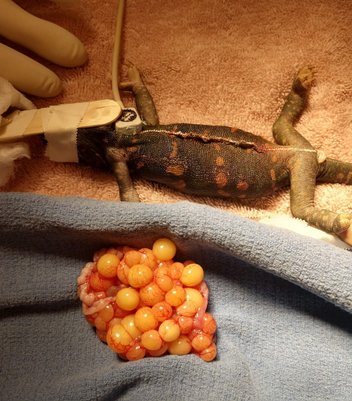
Dystocia, also known as “egg-binding” includes pre- and post-ovulatory stasis or obstructive dystocia. Pre-ovulatory stasis is when the ovaries have mature follicles but fail to ovulate or release the developing ova into the oviduct to develop shells. Post-ovulatory stasis occurs when mature eggs have developed in the oviduct but fail to be laid. A number of factors influence the development of either of these conditions and not all those factors are completely understood. However, without treatment, either condition will eventually lead to sickness and left untreated, death. Common causes include poor care or nutrition, lack of appropriate nesting sites, poor physical condition, nutritional secondary hyperparathyroidism, malnutrition, other dietary imbalances, endocrine problems, egg yolk coelomitis, and obstruction from bladder stones, tumors, abnormal egg confirmation, or anatomic anomalies.
It is normal gravid (pregnant) lizards may show loss of appetite, increased activity (especially nesting or pacing), and swollen coelom with palpable follicles or eggs. Signs specific to dystocia are depression, lethargy, hind limb weakness, straining, the passage of a few eggs but not a full clutch, discharge from the cloaca, and/or cloacal prolapse.
Conditions that may mimic dystocia include tumors, bladder stones, abscesses, or fecal impaction.
Diagnostic tests your veterinarian may recommend include radiographs and/or ultrasound, complete blood count, and serum biochemistry in order to diagnose the condition and look for any causative factors.
For stable patients, the only treatment necessary may be to provide proper environmental conditions and nesting sites for species. Unstable patients can be treated with medical or surgical therapy. Medical therapy includes fluids, assist feeding, calcium injections, pain control, and oxytocin. Surgery is often the treatment of choice which not only allows for removal of the eggs but spaying the lizard to prevent future problems. Following surgery, prescription medications will be recommended during recovery.
Dystocia can progress rapidly to death in lizards. The prognosis is fair to good with treatment and supportive care. Dystocia can recur if the lizard is not spayed. Medical management with oxytocin is less effective in lizards than it is in turtles and tortoises and it is not uncommon for patients to require surgery despite attempting this approach.
Without surgery, follow-up should occur daily to monitor nesting behavior, mentation, and activity levels. With surgery, it is recommended that a recheck examination and suture removal be scheduled in 4 weeks-6 weeks or sooner if not improving or worsening.
Copyright © All Rights Reserved